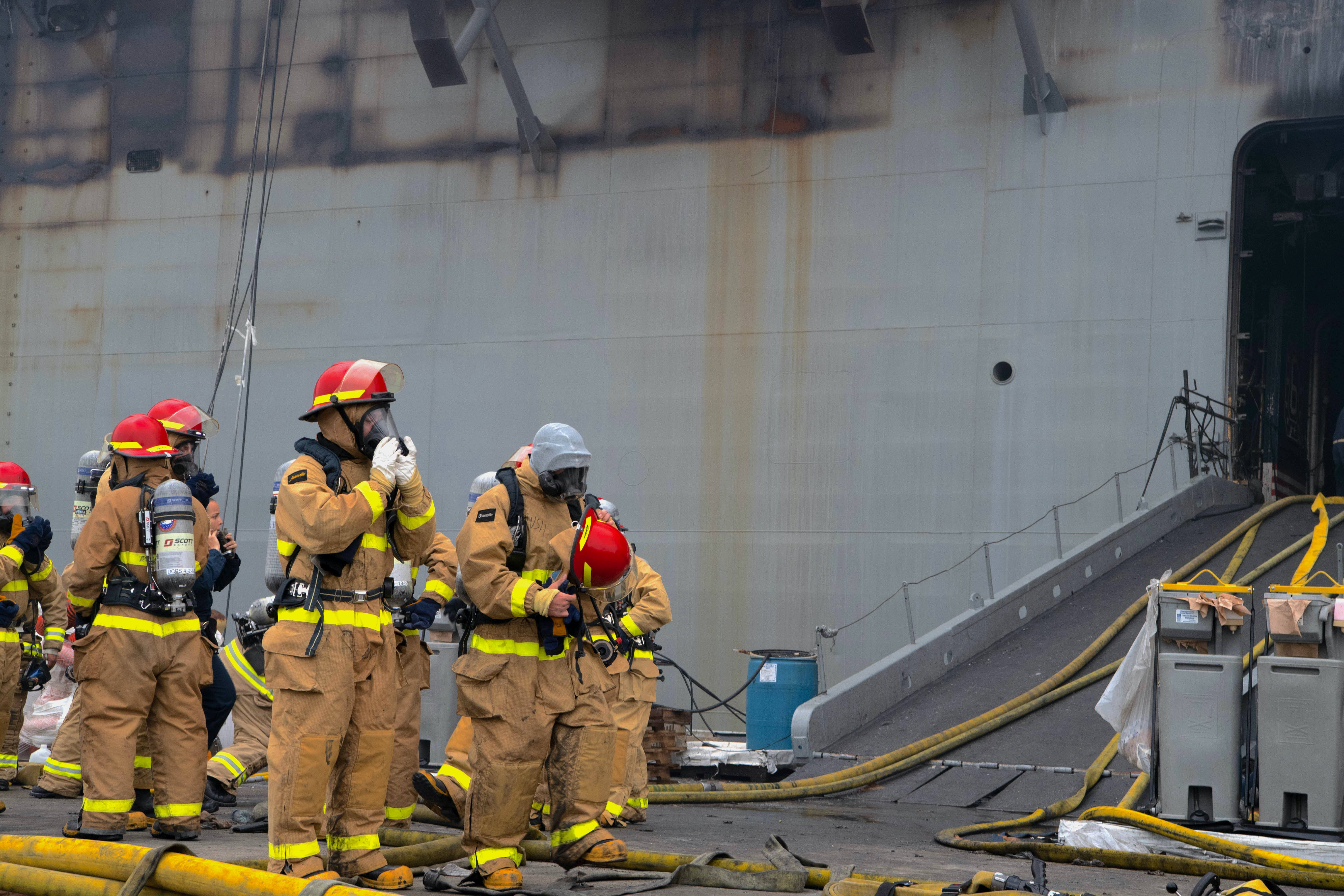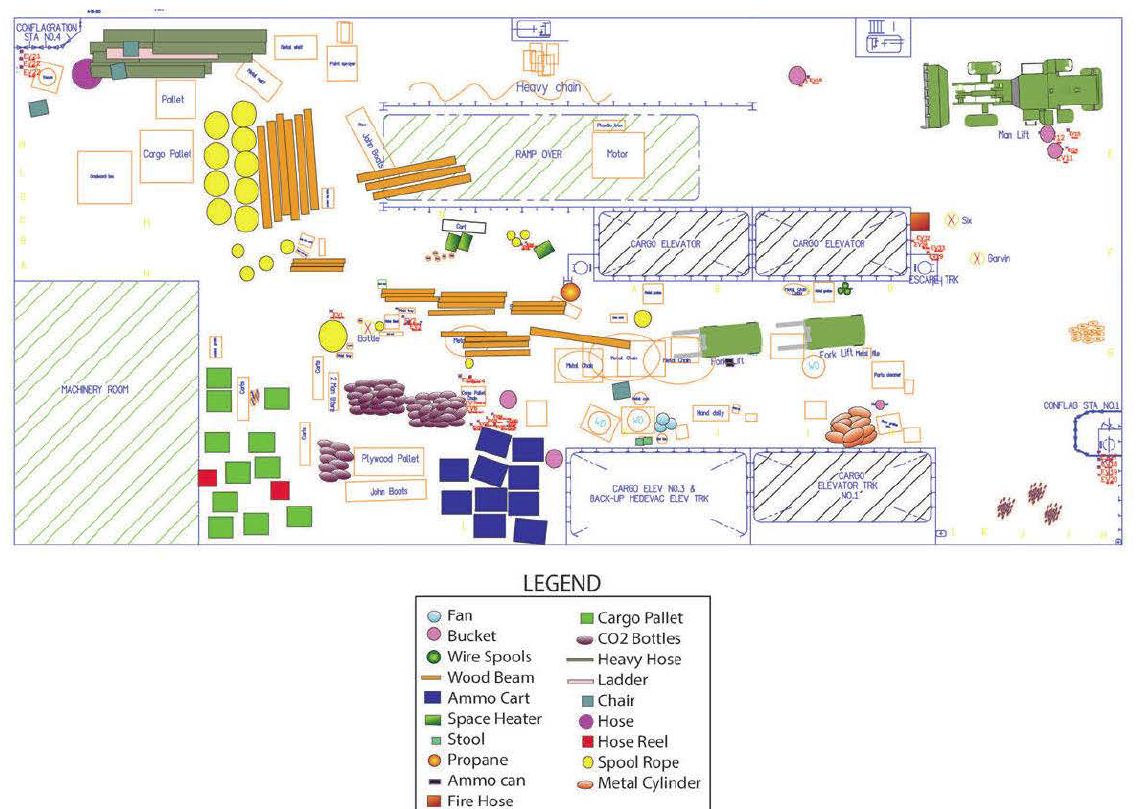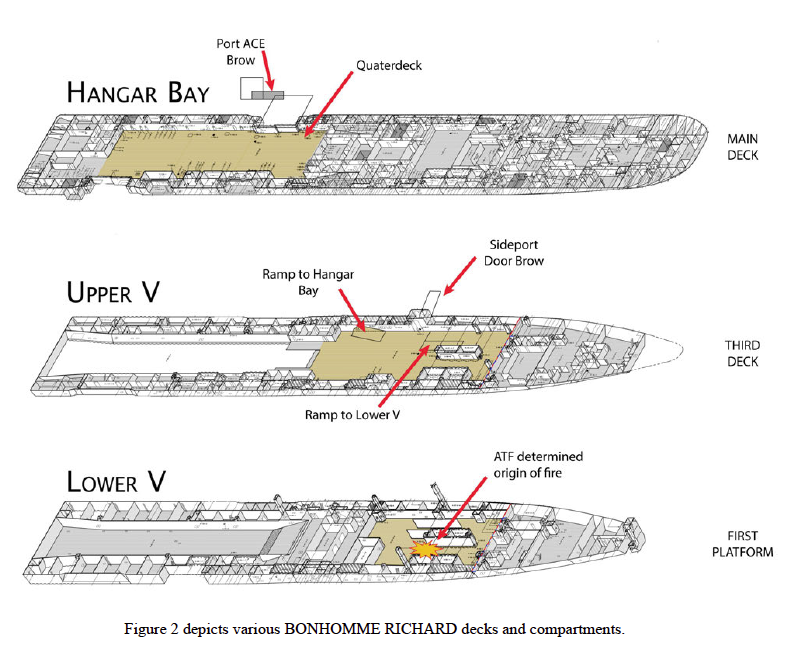
This post has been updated to correct the rank for Ryan Mays.
SAN DIEGO – One petty officer’s accusation against a shipmate is at the center of the Navy’s criminal case against the junior sailor charged with deliberately lighting a fire last year that caused the service to scrap the former USS Bonhomme Richard (LHD-6).
Personnel Specialist Third Class Kenji Velasco told a military court that he was standing watch when he saw someone walking in the lower vehicle deck not long before he saw smoke and soon after a fire that was first reported around 8 a.m. on July 12, 2020, aboard the amphibious assault ship.
Velasco said he later believed it was Seaman Ryan Mays, a sailor assigned to his duty section, and relayed that suspicion to Naval Criminal Investigative Service agents.
“He was wearing coveralls, a mask and a cover” and was carrying a bucket, Velasco said when questioned by prosecutor Cmdr. Richard Federico in the second day of an Article 32 preliminary hearing at Naval Base San Diego that will determine whether Mays should be court-martialed.
But Velasco admitted he didn’t tell investigators until his second interview into the fire’s cause exactly who he thought he had seen. At one point that week, with sailors massed outside the base theater to join in firefighting teams in the massive fire attack, Velasco said he asked Mays “if he went down to the Lower V prior to the fire.”
“He just said yes,” Velasco said.
Mays, who enlisted in May 2019, has denied any role in the fire.
Velasco’s contention that it was Mays, and not someone else, was questioned Tuesday by Mays’ attorneys defending him against charges of aggravated arson and hazarding a vessel.
Lt. Cmdr. Sharlena Williams noted that Velasco wrote in an NCIS questionnaire on the first day of the fire that “you saw someone go down to the Lower V” but didn’t specify it was Mays, which the sailor acknowledged. When interviewed by investigators on July 20, 2020, at NCIS’s San Diego office, “you told them that an unknown male went down to the Lower V,” Williams said. “Yes, ma’am,” Velasco replied.
In later cross-examination, he said that “I told them I thought it was Seaman Mays.”
Velasco, when questioned by Capt. Angela Tang, a military judge and the Article 32 hearing officer, said he was “100 percent” sure that it was Mays.
Velasco was interviewed several times by NCIS agents, as well as Matthew Beals, a special agent and certified fire investigator with the U.S. Bureau of Alcohol, Tobacco, Firearms and Explosives. The ATF investigation determined that the fire was deliberately set near heavy-duty cardboard boxes, but it could not conclusively determine whether it was lit by a flame or ignited by vapors.
Two investigators testified there’s no direct physical evidence and no DNA linking Mays directly to the fire. But Beals said in testimony Monday that a combination of Mays’ interrogations, statements from crew members and the discovery of a lighter in Mays’ locker led him to suspect the sailor may have set the fire.

The ATF agent also acknowledged there were “inconsistencies” in Velasco’s story and the details about what and who he saw in the Lower V that morning changed several times.
Despite that, Velasco was “the person who was closest to the Lower V, who had a description of Seaman Mays, and we believed him,” NCIS Special Agent Albert Porter said when questioned by Gary Barthel, Mays’ civilian defense attorney and a retired Marine Corps officer.
Defense attorneys’ line of questioning during the two days of government witnesses revealed their frustration with inconsistent or conflicting statements, assumptions made by witnesses and investigators, and lack of evidence to support the charges against Mays. They are expected to call several witnesses to testify Wednesday.
The government’s case against Mays involves at least 2 terabytes of evidence, which defense attorneys complained in court Monday they just recently received to review for the preliminary hearing that will determine if there’s probable cause to prosecute Mays at a court-martial.
Prosecutors contend that Mays was disgruntled over being assigned to Bonhomme Richard after he dropped out of the Basic Underwater Demolition/SEAL program, BUD/S, in its first week. Several crew members testified that Mays had a bad attitude, complained about being assigned to Deck Department and was disrespectful at times.
Porter interviewed Mays on Aug. 20, 2020, just hours before Mays was taken to the Consolidated Military Brig in San Diego for pretrial confinement. Porter testified that he “was kind of shocked how deceptive he was,” starting with lies about the extent of the sailor’s time at BUD/S training in Coronado, Calif., and inferring he had “loved every second” of Hell Week. Porter, a former SEAL, noted that Hell Week happens later in training.
During that interrogation, Mays led Porter and Beals on a walk-through on Bonhomme Richard, recounting his movement on the day of the fire. Back at the NCIS office, a video recording of that interrogation shows Mays looking defeated as the agents pressed him to admit his role in the fire. “You were just down there goofing around,” Porter told him. “It’s OK if it got out of control.”
“No… no… no… no,” Mays repeated, his head in his face at times.
“Man up. Take responsibility for your action,” the agent said.

Mays didn’t learn he was being confined to the brig until after that interrogation, when he was transported by brig chasers.
Master-at-Arms First Class Carissa Tubman, one of the chasers, testified Tuesday that shortly after being told he was being taken to the brig, Mays “looked kind of baffled and was more confused.” After an awkward silence, she said, he muttered to himself, “I’m guilty. I guess I did it. It had to be done.” A defense attorney suggested that Mays’ statement was not an admission of guilt and was taken of context.
Mays was held in the brig until Oct. 14, 2020, when he was released without being charged under the Uniform Code of Military Justice. He was assigned to Amphibious Squadron 5 in San Diego, his current duty. He wasn’t held in confinement after he was formally charged on July 29, 2021.
Tang is collecting evidence and testimony and will make a recommendation to Vice Adm. Stephen T. Koehler, the U.S. 3rd Fleet commander. As the convening authority in the case, Koehler had ordered the hearing to determine whether the charges against Mays should be handled at a court-martial, administratively handled or dismissed.





